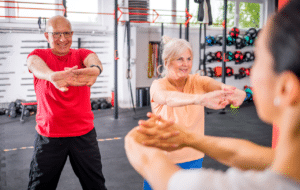Last Updated on October 15, 2025 by Arun
Age alone isn’t a limitation. Some older adults run marathons and climb mountains, while some younger people struggle with mobility. The real question for group exercise instructors isn’t “How old is my client?” but “How does my client present today?”
As we age, our bodies naturally change – muscle mass, bone density, and nervous system efficiency can all decline. These changes may affect movement, balance, and confidence, but with the right approach, instructors can create safe, empowering, and inclusive environments for older adults to thrive.
Rethinking risk
Two key risks to consider are bone mineral density loss and reduced balance or coordination, both of which can increase the chance of falls or fractures. But fear of injury can also hold people back, so the goal is to balance challenge with reassurance.
To do this:
-
Clearly explain every exercise before beginning.
-
Allow extra time between movements or position changes.
-
Use stable starting positions and wide bases for standing work.
-
Offer chairs, walls, or bars for support during balance exercises.
-
Gradually introduce challenge to improve confidence and function.
Safety isn’t about avoiding movement, it’s about teaching it well and supporting participants to move safely and successfully.
Adapting for health conditions
Many older adults live with long-term conditions such as osteoarthritis, hip replacements, or sensory decline. Instructors should understand how these affect class participation and adapt accordingly.
For example, after a hip replacement participants may:
-
Feel nervous about getting up and down from the floor.
-
Find it uncomfortable to lie on one side or move into deep flexion or extension.
Adaptations might include:
-
Using backward chaining (moving through a lunge while holding a chair) to get to the floor.
-
Providing support cushions to relieve pressure on the hip.
For other conditions, adaptations may include:
-
Adjusting music volume or tone if hearing is affected.
-
Allowing more time to transition between exercises if neural response is slower.
The key is to talk, observe, and listen. Even brief pre-class conversations or observations during movement can reveal valuable information about each participant’s needs.
Do’s and don’ts for teaching older adults
Do:
-
Create an inclusive, communicative environment where participants feel comfortable sharing health information.
-
Offer stable supports (walls, bars, or chairs) throughout the session.
-
Build in social time – chatting between exercises or a few minutes at the end for tea and conversation. For many, connection is the main reason they come to class.
-
Focus on functional movement – the actions that keep people strong and capable in daily life.
Don’t:
-
Prioritise high-intensity or high-impact training. It’s fine to include some challenge, but intensity shouldn’t be the focus.
-
Overload or over-repeat exercises.
-
Rush transitions – stability and confidence matter more than pace.
Encourage pair or group work when possible; it supports balance, social engagement, and confidence.
Teaching older adults isn’t about slowing down, it’s about meeting them where they are. With empathy, awareness, and careful programming, instructors can build classes that not only strengthen bodies but also reduce isolation and restore joy in movement.
EMD UK is the governing body dedicated solely to the group exercise community. Our members benefit from our guidance, CPD-accredited courses and over 250 resources. Pro membership with insurance starts from just £51 annually.



